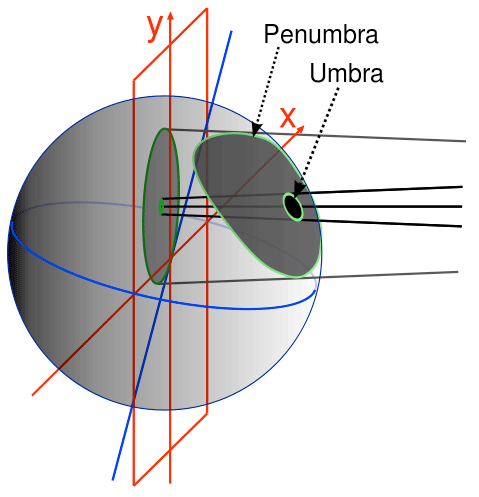In order to predict the general characteristics as well as the local circumstances for a solar eclipse, high accuracy ephemerides for both the Sun and the Moon are required. Conventional ephemerides tabulate the positions and distances of these bodies with respect to Earth's center. However, the solar eclipse calculator is primarily interested in the position, dimensions and velocity of the Moon's shadow on Earth's surface.
In 1824, the Prussian astronomer and mathematician Friedrich Bessel introduced a new method for the prediction of solar eclipses. It was so successful that it remains today as the most powerful technique, even with the application of the digital computer. The key to Bessel's method is the expression of the ephemerides of the Sun and Moon in terms of the Moon's shadow with respect to Earth's center. This change in the frame of reference greatly simplifies the mathematics and geometry without any sacrifice in accuracy.

To define the Besselian elements of an eclipse, a plane is passed through the center of Earth which is fixed perpendicular to the axis of the Moon's shadow. This is called the fundamental plane on which on X-Y rectangular coordinate system is constructed with its origin at the geocenter. The axes of this system are oriented with north in the positive Y direction and east in the positive X direction. The Z axis is perpendicular to the fundamental plane and parallel to the shadow axis.
The X-Y coordinates of the shadow axis can now be expressed in units of the equatorial radius of Earth. The radii of the penumbral and umbral shadows on the fundamental plane are identified as L1 and L2, respectively. The direction of the shadow axis on the celestial sphere is defined by its declination 'd' and ephemeris hour angle 'µ'. Finally, the angles which the penumbral and umbral shadow cones make with the shadow axis are expressed as f1 and f2, respectively. These eight parameters and their variations over time serve as the only input needed to characterize a solar eclipse. They may be tabulated at hourly intervals, or expressed as a series of third order polynomials over the several hour period of the eclipse.
The eight Besselian elements needed to characterize a solar eclipse can be summarized as follows:
- x, y - Cartesian coordinates of the lunar shadow axis in the Fundamental Plane (in units of Earth's equatorial radius)
- L1, L2 - Radii of the Moon's penumbral and umbral/antumbral shadows in the Fundamental Plane (in units of Earth's equatorial radius)
- d - Declination of the Moon's shadow axis on the celestial sphere
- µ - Hour angle of the Moon's shadow axis on the celestial sphere
- f1, f2 - Angles of the penumbral and umbral/antumbral shadow cones with respect to the axis of the lunar shadow
The details for actual eclipse calculations using the Besselian elements can be found in the references listed below.
References
Chauvenet, W., Manual of Spherical and Practical Astronomy, Vol.1, 1891 (Dover edition 1961).
Explanatory Supplement to the Astronomical Ephemeris and the American Ephemeris and Nautical Almanac, Her Majesty's Nautical Almanac Office, London, 1974.
Meeus, J., Elements of Solar Eclipses: 1951 - 2200, Willmann-Bell, Inc., Richmond, 1989.




